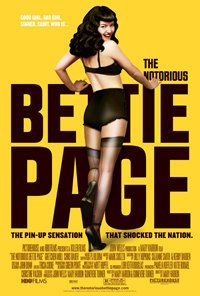 The Inner Life of Betty Page
The Inner Life of Betty PageMary Harron recreates the pinup milieu and its attendant fallout in The Notorious Betty Page (2005), an HBO movie shot mostly in black and white with occasional splashes of color. Harron, who directed the searingly good take on gender issues via Valerie Solanas in I Shot Andy Warhol, takes a subtler approach with Betty Page, though it's clear that the jump from the pinup 50s to Warhol's 60s is not a large one after all. The little romps made by camera clubs and "collectors" of Page and other models/actors are close forerunners to Warhol productions like Chelsea Girls (1966), and many of the themes blur together.
Betty Page (4/22/1923-) is "notorious" only in the lustful eyes of her male "consumers." Behind her happy-go-lucky persona, Page is smart, tenacious, and free-spirited, yet haunted by God. Nudity does not phase her, and she refers to the openness of Adam and Eve before the Fall more than once. She was abused by her father and by men singly and in groups before leaving Nashville and ending up in New York City. In the movie, there is something sinister about many of her "dates," and she is often either punished, exploited or judged for her beauty. The creepiness of many of the male characters reminds me of Silence of the Lambs. Harron's American Psycho (2000) covers this territory in a similarly extreme way. But Page's trajectory is successful and the choice to leave modeling in 1957 is hers. She is still alive, was sought after (like Ava Gardner) by Howard Hughes (she declined) and is still admired by Hugh Hefner, who featured her in Playboy in January 1955. The interactions between Betty Page and photographer Bunny Yeager in sunny Florida provide good contrast with the rest of the story.
Mary Harron's work is always interesting. Overall, The Notorious Betty Page is a leisurely-paced meditation on gender, sexuality, celebrity, persona, photography, modeling, acting, fantasy, and spirituality. Gretchen Mol is perfect in the lead role. Much of the cast will be familiar to HBO viewers: three minor roles for Sopranos fans; Chris Bauer from The Wire and Lili Taylor from Six Feet Under (she plays Valerie Solanas in I Shot Andy Warhol, as well). Harron has directed episodes of Six Feet Under and Big Love, so she's very much in the mix. As we all know by now, everything's connected to everything else upon closer examination.
Here's the official movie site, a fun one that is best viewed with a high speed connection:
http://www.thenotoriousbettiepage.com/ It's worth repeating: Gretchen Mol is great as Betty Page. Also: Harron was executive producer for the excellent 2002 documentary The Weather Underground.
Here's a live link to "Rapture Riders:" http://music.yahoo.com/ar-269864-videos--Blondie
This is my 100th post. Salud!








5 comments:
Can't wait to see the movie! Thanks for the update ;)
Erik,
The attraction-repulsion of women's power is complicated, to say the least. You are doing your best to be balanced, and for that I applaud your efforts. It must be difficult for men to find their way in today's world without being wretched.
Cindy
Erik, I'm curious about what you made of the shifts between b&w and color. I couldn't make sense of it myself...
I also thought the movie Bettie seemed so incredibly lonely, that maybe Harron was presenting subtle motivation for the urge to model. In any case, it was very enjoyable, and Mol was captivating as Bettie.
Maybe it was as simple as budget, as in some past films (Lindsay Anderson, for example). Not exactly The Wizard of Oz in its formula, though.
I think you're right on -- the modeling persona is incredibly lonely, maybe trying to affirm life despite past abuses among the same basic audience. Make herself right with God, who forgives all?
You can almost understand why she went into seclusion after it all... I bet she never expected any of it to become like this. =D
Post a Comment